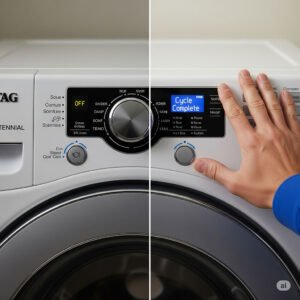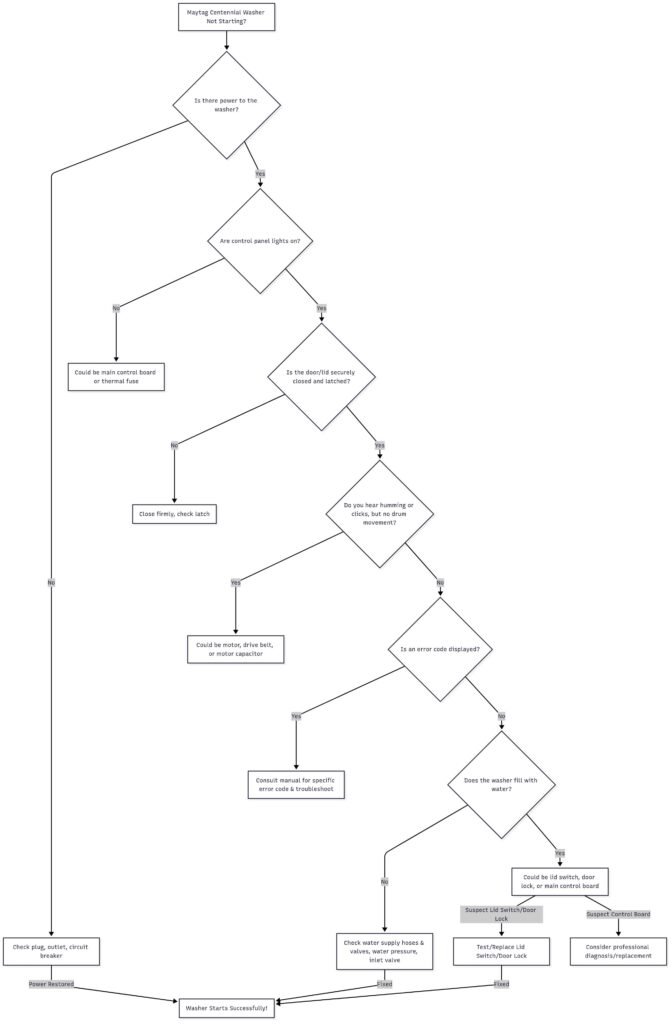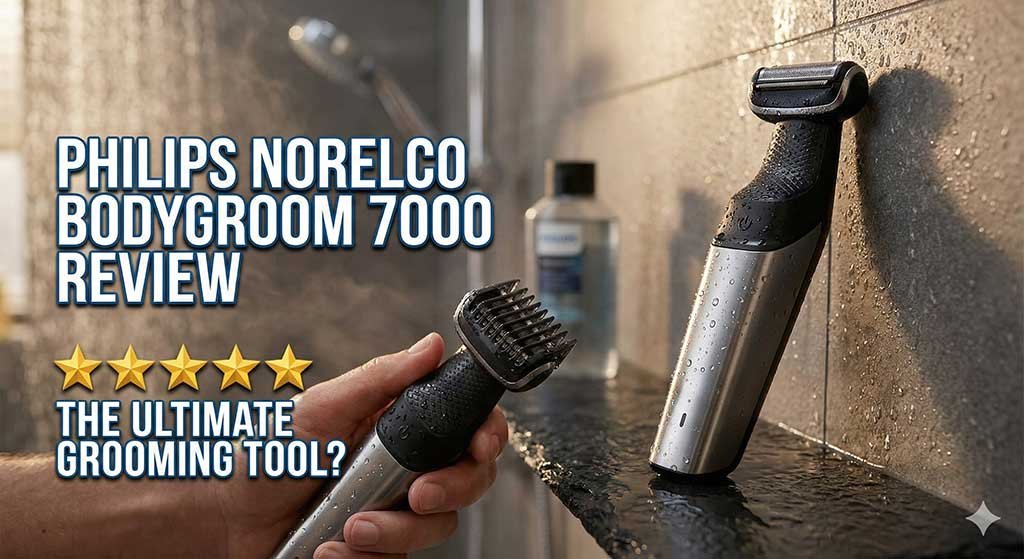Is your Maytag Centennial washer leaving you with a pile of dirty laundry because it’s not starting? Don’t toss in the towel just yet! This guide will walk you through common reasons why your Maytag Centennial washer might be acting up and, more importantly, how you can troubleshoot and fix many of these issues yourself. Get ready to dive into the world of washing machine repair and get your laundry routine back on track!

Table of Contents
Common Symptoms of a Non-Starting Washer
Before we delve into specific solutions, let’s identify what “not starting” might look like for your washer:
- Completely unresponsive: No lights, no sounds, nothing happens when you press the start button.
- Lights on, but no action: The control panel lights up, but the washer doesn’t fill, agitate, or spin.
- Humming sound, but no movement: You hear a noise, but the drum doesn’t move.
- Error codes displayed: Your washer might be trying to tell you something with a specific code.
How To Fix Maytag Centennial Washer Not Starting Problem
Before you start disassembling anything, let’s go through some basic checks. You’d be surprised how often a simple oversight is the culprit when your Maytag Centennial washer is not starting.
Power Supply: Is It Plugged In?
This might seem obvious, but it’s worth checking.
- Is the washer plugged in firmly? Sometimes, the plug can become loose.
- Is the outlet working? Plug another appliance, like a lamp or hair dryer, into the same outlet to test it. If the other appliance doesn’t work, you might have a tripped circuit breaker or a faulty outlet.
Circuit Breaker: Did It Trip?
Washing machines draw a lot of power. If there’s a power surge or an overload, your home’s circuit breaker might trip, cutting off power to the washer.
- Locate your home’s electrical panel.
- Look for a tripped breaker. It will usually be in the “off” position or in an intermediate position between “on” and “off.”
- Flip the breaker firmly to the “off” position, then back to “on.”
- Wait a few minutes before trying to start your washer again.
Washer Door/Lid Switch: Is It Engaged?
Modern washing machines have safety mechanisms to prevent operation when the door or lid is open. If this switch is faulty or not engaging properly, your washer won’t start.
- Close the washer door/lid firmly. Give it an extra push to ensure it latches securely.
- Listen for a click that indicates the switch has engaged.
- Inspect the latch mechanism for any visible damage or obstructions.
Water Supply: Are the Hoses Connected and Open?
While a lack of water won’t prevent your washer from starting in terms of powering on, it will prevent it from filling and thus starting its wash cycle.
- Check both hot and cold water supply hoses. Ensure they are securely connected to the back of the washer and to the wall outlets.
- Make sure the water supply valves are fully open. Turn them counter-clockwise to open them.
Common Component Failures
If the initial checks don’t resolve the issue, it’s time to investigate specific components that commonly cause a Maytag Centennial washer to be not starting.
Lid Switch Assembly: A Frequent Culprit
The lid switch assembly is a safety feature that prevents the washer from operating when the lid is open. It’s one of the most common reasons a washer won’t start.
- How it works: When you close the lid, a small lever or tab presses against a switch, completing an electrical circuit.
- Symptoms of a faulty lid switch: Your washer might power on but won’t fill with water or agitate. You might hear a click but no further action.
- Testing (with caution!):
- Unplug the washer first. Safety is paramount.
- Locate the lid switch assembly. It’s usually found under the top panel near the lid hinge.
- Visually inspect the switch for any broken parts, corrosion, or wires that have come loose.
- Using a multimeter (if you have one and know how to use it safely): Test for continuity across the switch terminals when the lid is closed. If there’s no continuity, the switch is likely faulty.
- Replacement: If the lid switch is faulty, it needs to be replaced. This is a relatively straightforward repair for most DIYers. You can usually find replacement parts online or at appliance parts stores.
Door Lock Mechanism: For Front-Loaders
If you have a front-load Maytag Centennial washer, it will have a door lock mechanism instead of a lid switch. This mechanism electronically locks the door during operation and ensures it’s securely closed before a cycle begins.
- Symptoms of a faulty door lock: The washer won’t start, or you might see an error code related to the door. The door might not lock, or it might not unlock after a cycle.
- Testing:
- Unplug the washer.
- Visually inspect the door lock assembly for any damage.
- Check the wiring to ensure all connections are secure.
- Using a multimeter: Test for continuity, similar to the lid switch.
- Replacement: A faulty door lock mechanism will need to be replaced.
Timer or Main Control Board: The Brains of the Operation
The timer or main control board (also known as the PCB or control unit) is the “brain” of your Maytag Centennial washer. It controls all the functions and cycles.
- Symptoms of a faulty control board:
- No power to the washer at all.
- Lights on the control panel are flickering or completely off.
- Washer doesn’t respond to any button presses.
- Specific error codes that point to a control board issue.
- Washer gets stuck in a cycle.
- Diagnosis: Diagnosing a faulty control board can be challenging without specialized tools or knowledge. Often, it’s a process of elimination after ruling out simpler issues.
- Replacement: Replacing a control board is typically more involved and can be costly. If you suspect this is the issue, it might be time to call a professional or consider the cost-effectiveness of repair versus replacement, especially if your washer is older.
As you can see, some repairs can be costly. If you’re on the fence about repairing your old washer versus buying a new one, you might want to consider a reliable brand. For example, you can learn more about the value of Speed Queen washers.
Drive Motor: The Powerhouse
The drive motor is responsible for spinning the wash tub and agitator. If it’s not working, your washer certainly won’t start its cycle.
- Symptoms of a faulty drive motor:
- Humming sound when trying to start, but no movement of the tub.
- Motor gets hot to the touch.
- Burning smell.
- Washer might fill with water but won’t agitate or spin.
- Diagnosis: This often requires more advanced troubleshooting, possibly involving checking motor windings or capacitors.
- Replacement: Replacing a drive motor is a significant repair and often best left to a professional.
Thermal Fuse: An Overheat Protector
Some washers have a thermal fuse, especially if the motor or other components are prone to overheating. This fuse acts as a safety device, blowing to cut power if the temperature gets too high.
- Symptoms: The washer will have no power whatsoever.
- Testing:
- Unplug the washer.
- Locate the thermal fuse. Its location varies by model but is often near the motor or control board.
- Use a multimeter to test for continuity. If there’s no continuity, the fuse is blown.
- Important: If the thermal fuse is blown, it’s crucial to identify and fix the underlying cause of the overheating, otherwise the new fuse will simply blow again.
Error Codes: What Says Your Maytag Centennial Washer
Many Maytag Centennial washer models have a diagnostic system that displays error codes. These codes are incredibly helpful in pinpointing the problem when your washer is not starting or malfunctioning.
How to Check for Error Codes:
- Look for the display panel. If your washer has one, an error code will usually appear there.
- Consult your owner’s manual. Your manual will provide a comprehensive list of error codes specific to your model and what they mean.
- Online resources: A quick search with “Maytag Centennial washer [your model number] error codes” can often yield results if you don’t have your manual.
Common Error Codes (Examples – Codes vary by model!):
Error Code Example | Potential Issue | What to Check |
dL | Door Lock Problem | Ensure the door is firmly closed. Check door lock mechanism for obstruction or damage. |
F5 | Lid Switch Error | Confirm the lid is closed. Inspect lid switch for proper engagement and damage. |
F7 | Motor Control Unit / RPM Sensor Error | This often indicates a problem with the motor or its control, possibly involving an overload. Call a professional. |
LF | Long Fill Time / Water Inlet Issue | Check water supply hoses for kinks or clogs. Ensure water valves are fully open. Check water pressure. |
No Power | Power Supply / Main Control Board | Check outlet, circuit breaker. If still no power, could be main control board or thermal fuse. |
Action Plan for Error Codes:
- Note the exact code.
- Consult your manual or an online resource to understand what the code signifies.
- Follow the recommended troubleshooting steps associated with that code.
Troubleshooting Flowchart
Here’s a simple flowchart to guide your troubleshooting process when your Maytag Centennial washer is not starting:

FAQ
Always start by checking the power cord to ensure it’s securely plugged into a working outlet. Next, check your home’s circuit breaker box to see if a breaker has tripped for the washer. Flip it off and then back on. If these don’t work, you might have a blown thermal fuse or a faulty main control board.
This often points to a problem with the lid switch assembly (for top-loaders) or the door lock mechanism (for front-loaders). These safety features prevent the washer from operating if the lid or door isn’t securely closed. Check for any obstructions and ensure the lid/door clicks shut properly.
A humming sound without drum movement often indicates an issue with the drive motor itself, a motor capacitor, or a stuck pump. The motor might be trying to run but can’t due to a fault or an obstruction. This usually requires professional diagnosis.
An error code is a valuable clue! First, note the exact code. Then, consult your Maytag Centennial washer’s owner’s manual or search online for that specific model and error code. The manual will provide specific troubleshooting steps for that error.
While a clogged drain pump primarily affects draining, a severe clog or an issue with the pump itself can sometimes cause the washer’s control system to prevent a new cycle from starting. This is usually because the washer detects it cannot properly complete a previous cycle or cannot drain, which would prevent it from filling for a new one.
If your top-load Maytag Centennial washer powers on but won’t fill or agitate, the lid switch is a prime suspect. You can visually inspect it for damage. If you have a multimeter and know how to use it safely, you can test for continuity across the switch when the lid is closed. No continuity means a bad switch. Always unplug the washer before inspecting or testing.
The decision to repair or replace a control board depends on the cost of the part, the labor involved, and the overall age and condition of your Maytag Centennial washer. Control boards can be expensive. If the repair cost is more than half the price of a new, comparable washer, or if your washer is very old, replacement might be the more economical choice in the long run.
Bottm Line
When your Maytag Centennial washer is not starting, it can disrupt your entire household. By systematically troubleshooting common issues like power supply, lid switches, and error codes, you can often resolve the problem yourself, saving time and money. Regular maintenance also plays a key role in preventing future headaches with your reliable Maytag Centennial washer.



